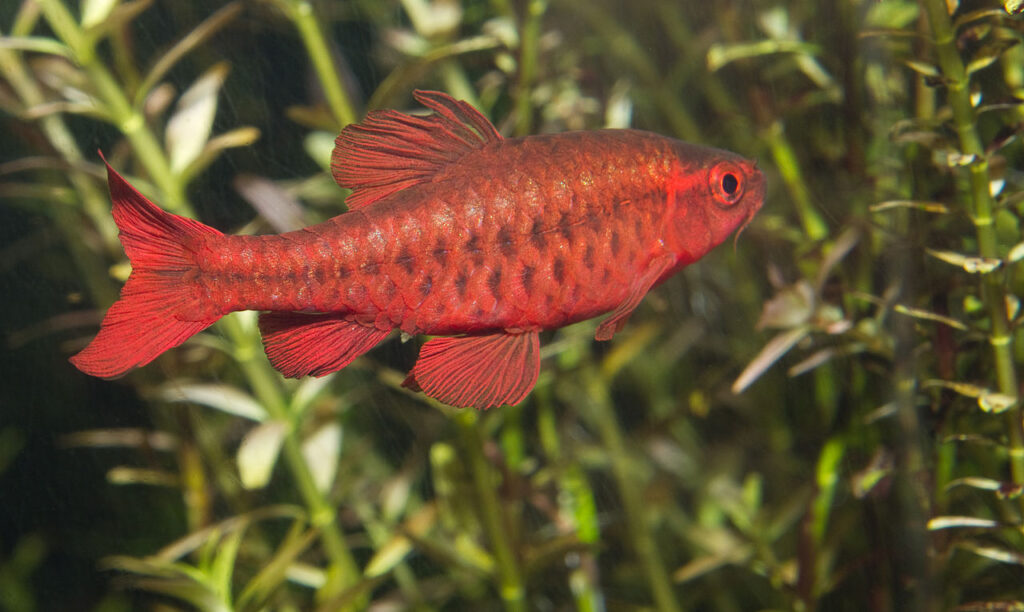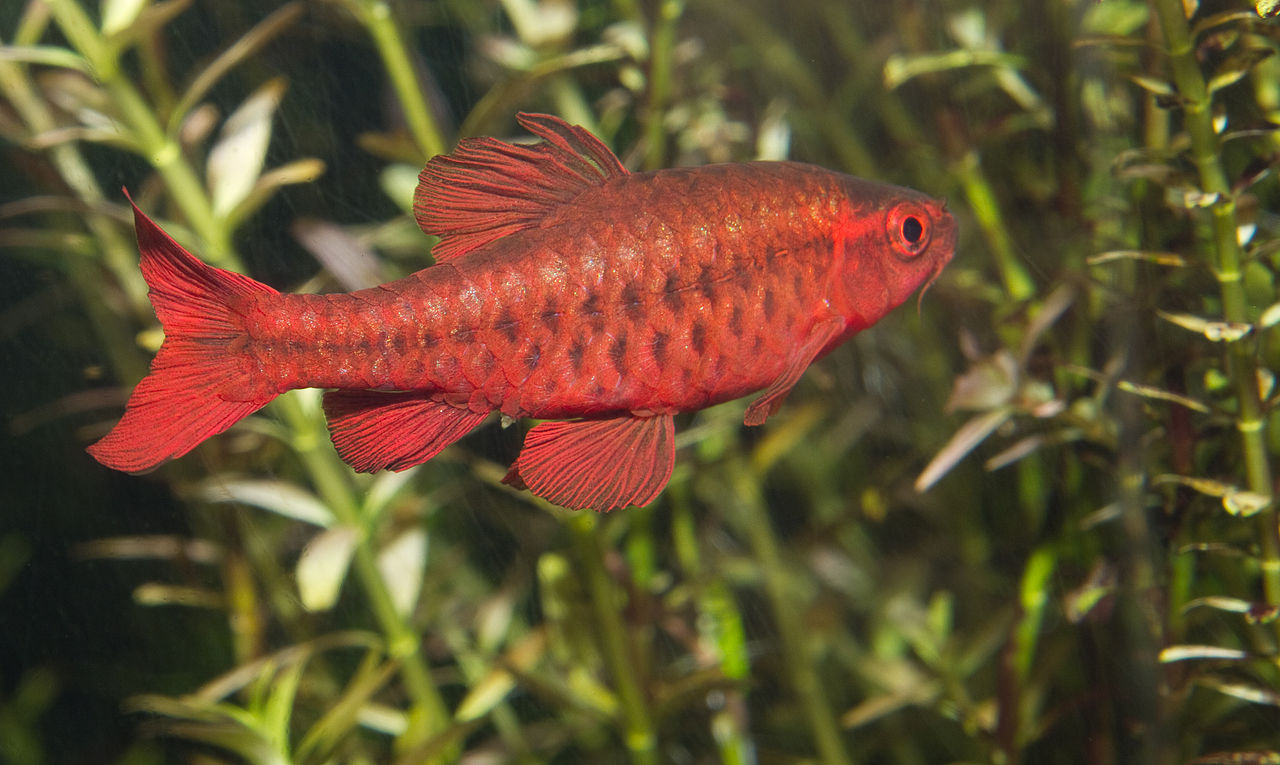Emerging from the mesmerizing depths of Sri Lanka’s pristine waters, the breathtaking Cherry Barb, scientifically referred to as Puntius titteya, makes its dazzling appearance. This mid-sized member of the Cyprinidae family boasts an array of colors and fits seamlessly into most freshwater aquariums. If you’re an aquarium enthusiast or a budding fish keeper, the Cherry Barb deserves your attention.
Table of Contents
Belonging to the vast Cyprinidae family, the Cherry Barb finds itself in the company of well-liked fish such as Danios, Rasboras, and fellow Barbs. A dazzling display of colors distinguishes it from the rest; males exhibit a bright cherry hue, while females exude a subtler silver or olive shade.
A common sight in the aquarium trade, the Cherry Barb is not classified as rare. While it doesn’t boast a wide range of variants, its inherent beauty is more than enough to captivate any fish lover.
Originating from the shaded, slow-moving streams of Sri Lanka, this fish relishes its natural habitat. Being an omnivore, its diet consists of small insects, algae, and plant matter, making it adaptable to various types of fish food in captivity. Characteristically a mid-dwelling species, it won’t shy away from exploring all areas of a tank. Their peaceful disposition makes them an excellent addition to community tanks.
A typical Cherry Barb grows to a length of 1-2 inches and, under optimal conditions, can live up to 5-7 years. The streamlined shape of their bodies facilitates their swimming efficiency. Furthermore, when males are feeling particularly extravagant, they enhance their vibrant colors in order to captivate and impress the females.
But, there’s more to this fish than meets the eye. Its history is deeply rooted in the aquarium hobby, enduring for decades. Yet, while it thrives in our homes, it’s essential to note that its wild populations face challenges due to habitat disruption. However, this hasn’t dampened the Cherry Barb’s enduring appeal.
For a sprinkle of fun, did you know that a mid-day ‘siesta’ in an aquarium can make a Cherry Barb’s colors even more vivid? Or that their tranquil nature is why many recommend them for first-time fish keepers?
In essence, the Cherry Barb is a delightful blend of beauty, history, and unique characteristics. Whether you’re planning to add one to your tank or simply appreciate the wonders of aquatic life, this fish truly shines in its own right.
The Cherry Barb: An Aquarist’s Gem

The Cherry Barb, with its radiant hues and amiable nature, is a favorite among aquarium enthusiasts. Hailing from the still waters of Sri Lanka, it beautifully balances aesthetic appeal with ease of care, making it an optimal choice for both novice and veteran aquarists. Below is a comprehensive table that provides insights into the Cherry Barb, assisting in ensuring its well-being and vibrant display in your tank.
| Family | Cyprinidae |
| Price | Varies, often affordable |
| Common Names | Cherry Barb |
| Variants | Standard (no major commercial variants as of 2021) |
| Ideal Tank Size | 20-30 gallons |
| Water Parameters | pH 6.0-7.5, Temperature: 74-81°F (23-27°C) |
| Lifespan | 5-7 years |
| Full Size | 1-2 inches (2.5-5 cm) |
| Natural Environment | Shaded, slow-moving streams in Sri Lanka with dense vegetation |
| Behavior | Peaceful, schooling |
| Habitat Preference | Mid-water level |
| Aquarium Decoration | Dense plantations, fine gravel, rocks, and driftwood |
| Ideal Tank Mates | Tetras, Rasboras, Danios, Corydoras, and other peaceful fish |
| Fish to Avoid | Aggressive or overly large species |
| Best Foods/Diet | Flake food, live food (like brine shrimp), frozen food, and plant matter |
| Disease | Susceptible to common freshwater diseases like Ich |
| Sex-switch | No known sex-switching behavior |
| Gender Differences | Males are brighter in color, females are more silver or light olive |
| Care Level | Easy to intermediate |
| Breeding Level | Moderate; they scatter their eggs among plants |
Acquaint yourself with the details above and create a home for your Cherry Barb that mimics its natural habitat. This will guarantee a vibrant, healthy, and long life for your fish.
Ideal Tank Mates
Establishing a community aquarium requires a delicate equilibrium among the various fish species. The Cherry Barb, with its peaceful temperament, is a delightful addition to many freshwater tanks. However, ensuring they coexist harmoniously with other species requires some consideration. Optimal tank mates should mirror the Cherry Barb’s peaceful nature, thrive in similar water parameters, and have comparable sizes to prevent bullying or predation. Here’s a detailed look at 10 ideal tank mates for Cherry Barbs:
- Tetras (e.g., Neon Tetras, Cardinal Tetras)
These small, vibrant fish are active schoolers, just like the Cherry Barb. Their non-aggressive nature ensures they coexist peacefully. Moreover, their vivid colors can complement the Cherry Barb’s hues. - Rasboras (e.g., Harlequin Rasbora)
These are small, schooling fish renowned for their peaceful temperament. Rasboras share similar habitat preferences with Cherry Barbs, preferring densely planted environments. - Danios (e.g., Zebra Danio, Pearl Danio)
Active swimmers, Danios can add a burst of energy to a tank. Though they’re fast, their peace-loving nature makes them suitable companions for Cherry Barbs. - Corydoras Catfish
These are bottom dwellers, which means they’ll occupy a different space in the aquarium. They’re calm, non-aggressive, and help keep the tank’s substrate clean. - Dwarf Gouramis
These fish are not only colorful but also tranquil. Their preference for the top and middle layers of the aquarium can ensure that they don’t encroach on the Cherry Barb’s territory. - Platies
With a plethora of color options, Platies are livebearers known for their peaceful disposition. They’re hardy and adapt well to community settings. - Mollies
Like Platies, Mollies are livebearers and are easy-going by nature. Their varied colors can further accentuate a tank’s aesthetics. - Otocinclus Catfish
These are efficient algae eaters and are very docile. Being small, they won’t intimidate or challenge the Cherry Barbs. - Ghost Shrimp
While not fish, these shrimps can add another dimension to your tank. They’re great scavengers and, being transparent, offer a unique visual. - African Dwarf Frogs
These fully aquatic frogs are peaceful and can coexist well with Cherry Barbs. They usually stay at the bottom and occasionally dart up for air.
By integrating these species with your Cherry Barb, you can establish a balanced, diverse, and harmonious aquatic community. Remember to always monitor the behavior of new additions and ensure that your tank size accommodates the needs of all its inhabitants.
FAQs
Why is my Cherry Barb hiding a lot?
The behavior of Cherry Barbs can be influenced by a variety of factors. If your Cherry Barb frequently hides, it could be a result of various factors, such as stress, the presence of aggressive fish in the tank, abrupt changes in water conditions, or insufficient hiding places and vegetation that make them feel vulnerable.
Can Cherry Barbs live in a tank without a heater?
While Cherry Barbs can tolerate a range of temperatures, a stable environment is key. If you live in a region where the temperature drops significantly, a heater is recommended to maintain a consistent water temperature within their preferred range.
Are Cherry Barbs jumpers? Do I need a lid for my tank?
While Cherry Barbs are not notorious jumpers like some other species, any startled or stressed fish might jump. It’s a good precaution to have a lid on your tank to prevent any accidental leaps.
Can Cherry Barbs be kept with shrimp?
Generally, Cherry Barbs can coexist with larger shrimp species. However, they might prey on very small shrimp or shrimplets. If you wish to keep a shrimp colony, especially of smaller species, ensure there are ample hiding spots.
How can I enhance the color of my Cherry Barb?
Cherry Barbs naturally exhibit brighter colors in well-maintained environments. Offering them a varied diet, including high-quality flakes, live food, and frozen food can enhance their color. Additionally, keeping them in a stress-free environment with suitable tank mates and proper water conditions can also help.
Can I keep a single Cherry Barb?
Cherry Barbs are schooling fish and thrive in the company of their own kind. It’s recommended to keep them in groups of at least 5-6 to ensure they exhibit natural behavior and feel secure. A lone Cherry Barb might become stressed or display subdued colors.
Why are my Cherry Barbs chasing each other?
While Cherry Barbs are generally peaceful, chasing can be a part of their natural behavior, especially during breeding periods. Males often chase females or compete with other males. However, excessive chasing can also be a sign of stress or territorial disputes, so it’s essential to monitor to ensure it doesn’t escalate to aggression.
Do Cherry Barbs eat plants?
Cherry Barbs are omnivorous and have a varied diet. While they will nibble on soft plants, they’re not known to cause significant damage to well-established plants. If you’re concerned about your aquarium plants, consider incorporating more robust plant species or feeding your Cherry Barbs a well-rounded diet to minimize nibbling.
Is it normal for Cherry Barbs to have a pale color at times?
Cherry Barbs may appear lighter in color in specific situations, like after a water change, when adapting to a new environment, or when the lights are turned on. Consistently pale colors, however, can be indicative of stress, illness, or poor water quality. If paleness persists, it’s advisable to check the water parameters and observe for any signs of diseases.
Do Cherry Barbs need a specific light setting?
While Cherry Barbs don’t demand any specialized lighting, a standard aquarium light that mimics a natural day-night cycle benefits them. Their colors become more vibrant under suitable lighting. However, they do appreciate some shaded areas or dim periods during the day.
What’s the best substrate for Cherry Barbs?
A fine, soft substrate, such as sand or fine gravel, is ideal for Cherry Barbs. This is especially true if aiming for a natural-looking habitat. Plants root well in such substrates, and the soft nature ensures that the barbs don’t injure themselves while foraging.
Can Cherry Barbs coexist with snails?
Generally, Cherry Barbs can peacefully coexist with most freshwater snail species. Snails can even benefit the tank by cleaning algae and consuming detritus. However, be cautious with snail overpopulation, as they might alter the tank’s balance if left unchecked.
Do Cherry Barbs need a specific water flow in the aquarium?
Cherry Barbs come from slow-moving or still waters in their natural habitats. Thus, they prefer a gentle water flow in the aquarium. Overly strong currents might stress them out. Using adjustable filters or strategically placing plants and decorations can help in achieving the desired water flow.

Leave a Reply